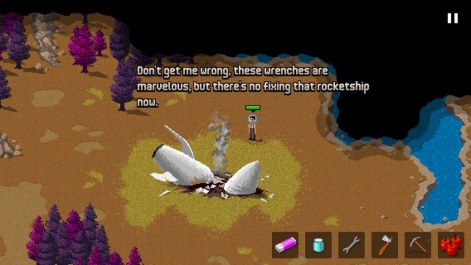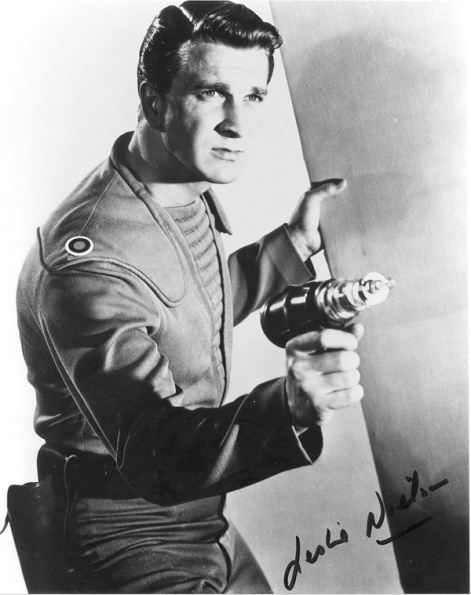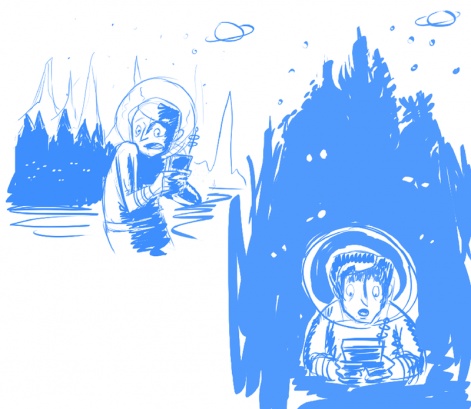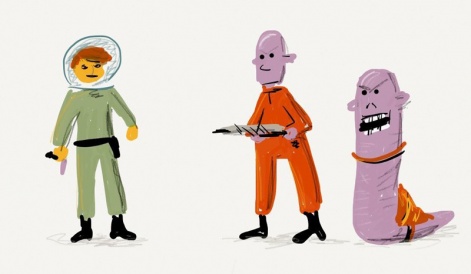When you think of the cosmos in video games your brain likely conjures up images of dilapidated space stations, rocky planetoids and a thousand twinkling stars.
Developer Big Bucket's vision in its iOS game Space Age: A Cosmic Adventure is different, however.
Its vision of humanity's jaunt into the wider universe is a more grounded imagining - familiar even - taking place almost completely on an Earth analog called Kepler-16.
Matt Comi created Big Bucket as a side project in 2006, where he initially developed dashboard widgets. During this time, he met Neven Mrgan online.
With Comi based in Perth, Australia, and Mrgan living in Portland, Oregon, the two began working remotely on iPhone apps as third-party contractors in 2007.
Comi released his first game, Pocketball, in 2009. In December the same year the pair began working on their first iOS game together, The Incident, which was released in 2010 and allowed Comi to resign from his day job.
Finally the space race could begin.
My god, it's full of stars
Space Age blends lots of different gameplay ideas, with point and click adventure elements sitting comfortably alongside real-time strategy, and a bit of stealth thrown in for good measure.
Inspired by games such as Command & Conquer and Cannon Fodder, Space Age was originally pitched as a pure mobile RTS, but stripped back and zoomed in to accommodate for mobile.

"We did some prototyping on basic game mechanics that blended ideas from these two games, at the same time discussing setting and story," recalls Comi.
Once settled on an alien planet as the setting Mrgan emailed Comi a black and white picture of a uniformed man with slick hair and an energy pistol of some kind - the photo looks like it could be a still for a live action version of The Jetsons.
This image influenced the aesthetics and direction of Space Age: our future seen from the eyes of the past - that ethos carried into the visual design with its pixel art inspired by retro classics.

"My biggest pixel inspirations are NES and Amiga games," says Mrgan.
"For Space Age, I wanted to combine the cute, chunky realism of Cannon Fodder with the crisp colours of Super Mario Bros 3.
"When we chose [1956 film] Forbidden Planet as our aesthetic guide, it helped establish the basic colours. After that, I find that pixel art at this scale is mostly a matter of 'make it read'."
Space Age is a game about 1950's American values: progress, optimism and community.
From this point Space Age began to find its own identity. It started as an RTS, morphed into a stealth action game and was later blended with adventure game elements.
"It sounds weird, but it felt normal at the time. Development was very fluid," says Comi.
"What started as a straight up RTS eventually blended into a mash-up of genres - the characters were large enough on screen that they gained a personality not usually present in real-time strategies.
"From there, we experimented with making them talk, examine items, pick up items and show items to other characters."
Make it so
The game was created with tools built by Comi. These helped with the design of the particle systems, previewing sprite sheet animations and converting truetype fonts into something usable in OpenGL.
Comi also wrote a map editor which was used to design the maps, configure mission rules and define dialogue. These tools helped the game evolve from its RTS beginnings.
You can still see evidence of the game's heritage in the way you select units and the metallic resource - once intended to be currency, now repurposed as a story element in the $3.99 paid title - that litters the planet and gets hoovered up by automated vehicles.

Other details - like placeholders for different unit types and architectural features - were scrapped completely. Narrative was suddenly king.
"It was really a matter of trying ideas to see what would stick," remembers Comi. "For as many ideas that made it into the game, there were probably just as many that were abandoned."
Once it started to take shape, Comi and Mrgan began planning the story outline over instant messaging. Once broken down into missions, the pair discussed them in detail over FaceTime, and development of the mission would start soon after, with Comi writing in placeholder dialogue and Mrgan coming in to flesh it out and draw the artwork.
For Mrgan, Space Age is a game about 1950's American values: progress, optimism and community. A sanguine vision of a future where humanity can put aside its petty conflicts, escape our claustrophobic sphere and explore the galaxy together.
As for conflict in the game, there are points where pacifism is not only an option, it's encouraged.
Home is where your Discombobulator is
"Space Age is 'retro-futuristic': our future, as imagined by our past," explains Mrgan.
"One thing that I find cute about old sci-fi is how ambitious the writers would get about certain things - intelligent robots as home appliances, everything is a laser - but then stay very grounded and conservative about others; astronauts, who are military men for some reason, smoke inside their rocket-shaped spaceships.

"So we looked for ways to run the old against the new, which then led to the theme of 'what was strange is now familiar, what was familiar is now strange.'
"The most bizarre thing you could find on a faraway alien planet is… what you left at home."
The most bizarre thing you could find on a faraway alien planet is… what you left at home.Neven Mrgan
Setting the scene
It's fitting, then, that Space Age ends with something intrinsic to humanity: a song.
As the credits roll, players are treated with an upbeat musical number performed by Cabel Sasser. Asked to create a 'propaganda song', Sasser took the idea and ran with it, coming back with a huge studio recording that treats players with an uplifting moment after the game's somewhat melancholy ending.
"It was mindblowing," says Comi. "Although Space Age has a visually retro aesthetic, we always wanted it to sound as real and cinematic as possible.
"All sound effects are positional. You can, for example, pan across a shrouded map and get a sense of where the lakes are by the sound and direction of the rippling water."
Comi developed a system that hooks the sounds into the mission rules - this allows the music to change dynamically to match what's happening in the mission.
"For instance, the first time you kill an alien, there is a quick orchestral stab," explains Comi. "Sasser wrote all of the music. I would provide him with video of the sequences that need music - using a shared Dropbox folder - and he'd write music to match the sequence."
Like Space Age's climatic musical number, Comi and Mrgan's story seems to have ended on a happy note, with mobile sales meeting expectations. It's since been launched on the Mac App Store too.
As for what's next for the duo, don't expect a robot with a built-in toaster and laser cannon. Their next project will be something smaller in scope, something anyone can pick up and play.
It's time to come back down to Earth.
Space Age: A Cosmic Adventure is available from the Apple App Store, priced $3.99.





















